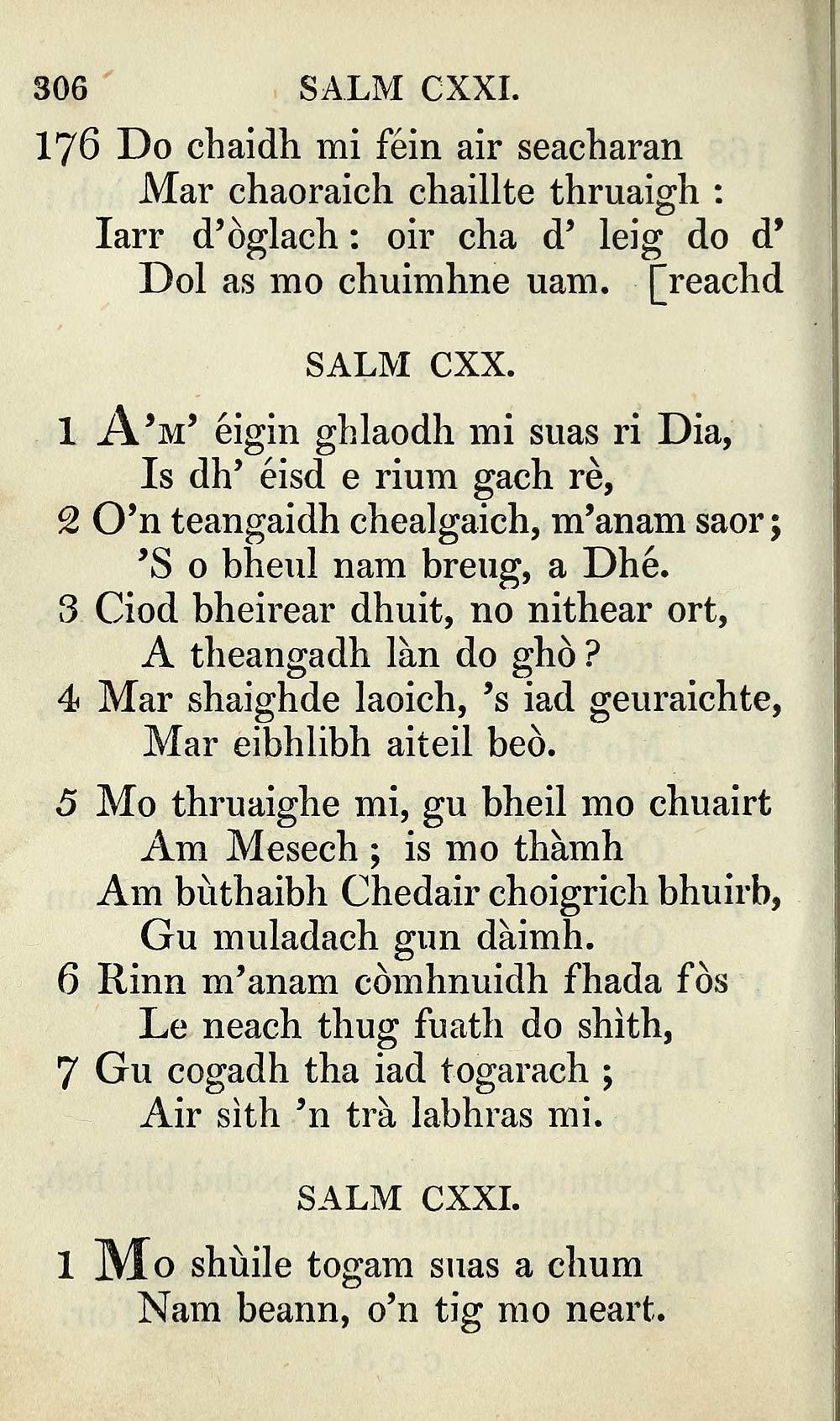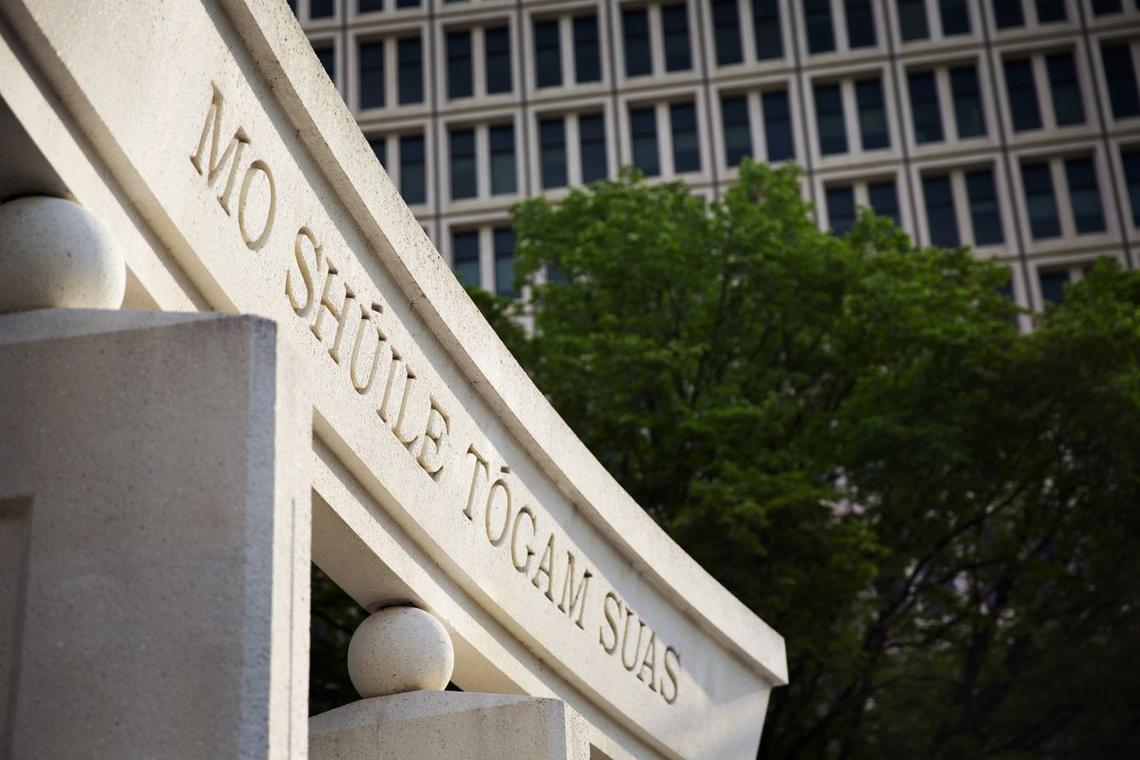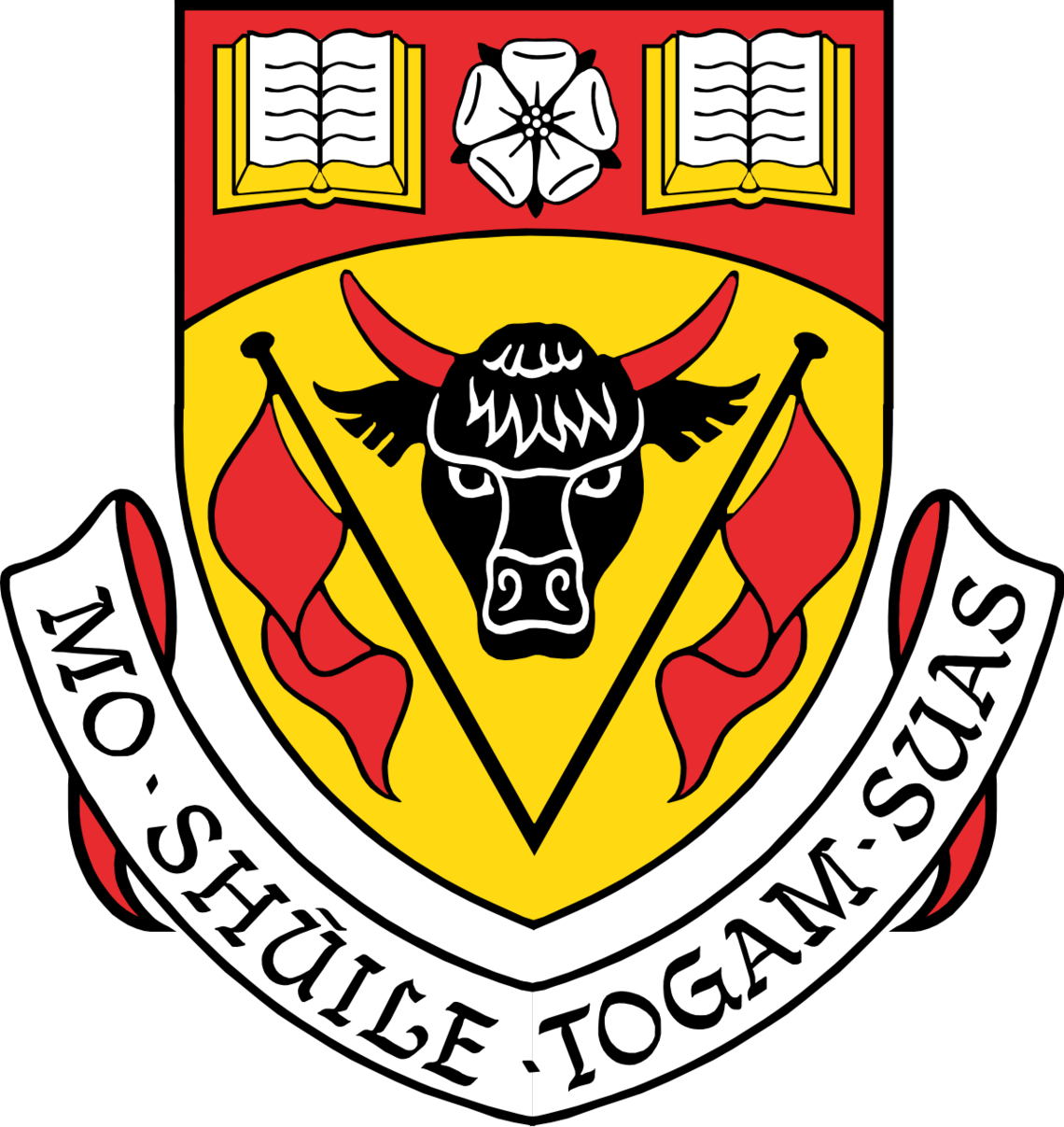Motto matters
The University of Calgary’s motto is inscribed atop the “Building the Vision” Donor Wall. The motto, which is pronounced “moh HOO-luh TOH-gum SU-us” (listen here) and translated as “I will lift up mine eyes,” is meant to be in Scottish Gaelic, in recognition of the Scottish heritage of the founders of the University (and of Calgary more generally), but it is easily mistaken as Irish for reasons that I describe below.

The phrase is adapted from Rev. Dr John Smith’s (1786) revised translation of Psalm 121:1, “I will lift up mine eyes unto the hills, from whence cometh my help.” The verse can be seen at the bottom of the page shown here, from Smith’s revised Gaelic Psalter.

For some reason, the Gaelic phrase was inscribed using Irish orthography on the Donor Wall (see other nice pics here and here), with an Irish acute accent (síneadh fada, pronounced “SHEE-nuh FAH-duh”), replacing the Scottish grave accent on <u> (symbolizing “oo”) in shùile ‘eyes,’ and with another acute accent added to <o> in togam ‘I (will) lift,’ as required only in Irish, to symbolize the vowel sound “oh.”

The motto also appears in the university’s Coat of Arms, granted by the Lord Lyon King of Arms at Edinburgh in 1966. As shown below, Mo shùile togam suas is written correctly in Gaelic uncial letters on the escroll below the shield, so I assume that the use of Irish accents on the Donor Wall three decades later was an honest mistake (or else the desperate action of a rogue Irish nationalist).

Turning now to grammar, the noun phrase mo shúile is used for “my eyes,” but this is correct only in Irish (e.g., Tá mo shúile gorm ‘My eyes are blue’). In Scottish Gaelic the correct form is mo shùilean (pronounced “moh HOO-lynn”), with the usual plural ending -(e)an. While the regular form mo shùilean certainly occurs elsewhere in Smith’s translations (e.g., Psalms 119:18, 119:123, 141:8; see also 115:5, 135:16), irregular mo shùile seems more common (e.g., Psalms 13:3, 25:15, 69:3, 101:3, 119:37, 123:1). We must therefore assume that -e was a possible plural ending in Classical Gaelic. This “Irishism” in Biblical Gaelic is probably related to the fact that while translators of the Bible used original sources in Greek (e.g., James Stuart) or Hebrew (e.g., John Smith), they nonetheless drew on earlier translations of the Bible into Irish by William Bedel (1571-1642) among others. (Note that the Irish have had the Bible for some time now, via St. Patrick († AD 493) et seq.)
Focusing now on the verb form, togam, it is unknown in modern Gaelic, but appears close to togaim (Irish “tógaim”), meaning “I lift/raise.” To be sure, the future tense is considered discretionary in Psalm 121:1 (and elsewhere) in some (admittedly less textual) English translations of the Old Testament, such as the New International Version (International Bible Society 1984) which has this verse translated as “I lift up my eyes to the hills...” From this perspective one might reasonably suggest that the suffix -am on tog ‘lift/raise’ is a now-defunct variant of the present tense first personal singular suffix -aim. Indeed togam appears for present tense “I lift” elsewhere in 18th century Gaelic translations (e.g., Psalm 25:1).
Another possibility, also under supple translation, is that togam ends with the first person singular imperative suffix -(e)am. The imperative interpretation of togam as “let me lift/raise” was recorded in Dwelly (1901:957), and is assumed here, but is no longer available in Gaelic. As Calder (1923:238:§166) warned, “The 1st sing[ular Imperative] is rare in literature, and has almost ceased to be spoken. [E.g.,] Cluinneam do sgeul ‘Let me hear your story/news.’” The imperative analysis of togam is thus transparent grammatically, but may unfairly call into question Gaelic translators’ faithfulness to biblical sources.
Yet another possibility is that togam is an archaic form for togaidh mi (pronounced “TOW-gee mee”), standard Gaelic for “I will lift.” According to Dwelly (1901:958), this is precisely what Armstrong (1825) reported for his Perthshire dialect. Crucially, liturgical Gaelic is largely based on this central Scottish dialect of several centuries ago, so the interpretation of Biblical togam as “I will lift” is plausible historically, if opaque grammatically.
Finally, we turn to two aspects of the motto which are motivated poetically. First, the motto’s word order is unusual. The canonical pattern in Gaelic sentences (and in Celtic more generally) is verb-initial, as in togam suas mo làmhan ‘I will lift up my hands’ (Psalms 63:4; also Psalm 119:48), or togam m’anam riutsa suas ‘I lift up my soul unto thee’ (Psalm 25:1). (Carmichael (1900) recorded “I will raise mine eyes upwards” as Togam suas mo shuil an aird in Carmina Gadelica.) In the motto, however, the object mo shùile is fronted (“left-dislocated”), which is certainly allowed in Gaelic grammar (Andrew Carnie, p.c.), but the consequent focus on mo shùile is capricious in Psalm 121:1 (and elsewhere, e.g., Psalm 123:1).
Another feature of the motto that is presumably motivated by poetics is the last word, suas, meaning ‘up.’ It is semantically implicit in the verb form togam and is unnecessary grammatically, in the same way that “up” is optional in English “I will lift (up) mine eyes.” (The location of suas/up also varies optionally; compare Psalm 63:4 and Psalm 25:1 cited earlier in the preceding paragraph.)
Altogether, then, the university’s motto Mo shùile togam suas ( Mo shúile tógam suas on the Donor Wall) is quite idiosyncratic, for better or for worse, and its intended meaning, “I will lift up mine eyes,” translates more readily in Scottish Gaelic as Togaidh mi mo shùilean (pronounced “TOW-guee mee mo HOO-linn”). Indeed Psalm 121:1 is so translated on occasion (e.g., here and here). This verse is also adapted as modern (if stylized) Gaelic Mo shùilean togaidh mi suas at the Gaelic Psalm Singing School (link expired).
(Many thanks to Andrew Carnie for valuable discussion, to Corey Telfer and Laurie Snell for her recording of the motto said by Larry MacDonell from Mabou, Cape Breton, and to John McDonald for use of his picture in the banner.)
References:
Armstrong, Robert Archibald. 1825. A Gaelic Dictionary in Two Parts: I. Gaelic and English. II. English and Gaelic; In which the Words in their Different Acceptations are Illustrated by Quotations from the Best Gaelic Writers, and their Affinities Traced in Most of the Languages of Ancient and Modern Times. With a Short Historical Appendix of Ancient Names Deduced from the Authority of Ossian and Other Poets, to which is Prefixed a New Gaelic Grammar. London: J. Duncan.
Calder, George. 1923. A Gaelic grammar containing the parts of speech and the general principles of phonology and etymology with a chapter on proper and place names. Glasgow: Gairm Publications, 1972.
Carmichael, Alexander. 1900 [1992]. Carmina Gadelica: Hymns and Incantations Collected in the Highlands and Islands of Scotland in the Last Century. Edinburgh: Lindisfarne Press.
Dwelly, Edward, ed. 1901. The Illustrated Gaelic-English Dictionary Containing Every Gaelic Word and Meaning Given in all Previously Published Dictionaries, and a Great Many Never in Print Before, to which is Prefixed a Concise Gaelic Grammar. Glasgow: Gairm Publications, Ninth ed., 1977. First edition original publication, 1901-1911.
International Bible Society. 1984. New International Version Bible. Grand Rapids: Zondervan.
Smith, John, rev. 1786. Sailm Dhaibhidh ann dan Gaelach, do reir na Heabhra, agus an eidir-theangachaidha 's fearr ann Laidin, ann Gaelic, 's ann Gaill-bhearla. Do thionnsgnadh le Seanadh Earra-Ghael 's a' bhliadhna 1659. Perth: Clodh-bhuailte ann Peairt, le Eoin Gillies.
[May 23, 2012]
